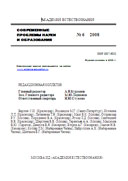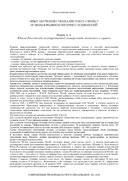PDF-версия статьи


|
1) an opportunity for the expansion of the range of speed regulation down from the nominal value (without appearance of the stepping effect);
2) an opportunity for the decrease of the mass-and-overall dimensions and manufacturing cost of the filter on the input stage of the inverter;
3) the electrical losses in the rotor circuit of an AC motor decrease (it is especially important for the induction motors with solid rotors) and other improvements [1-5].
Besides, the increase of the phase number is the most economical way to expand the power range of AC inverter drives (in the direction of increasing their powers), including the electrical drives with transistor inverters, because in this case it is possible to use the less (than when the phase number is equal to three) power semiconductor devices (transistors, thyristors, diodes) without any parallel connection of them.
The phase number being equal to five or more, it is also possible to use a number of non-traditional algorithms of inverter control. Using them it becomes possible to decrease the mass-and-overall dimensions of the traction electric drives (or drives having the analogous mechanical characteristics) by the use of the less power motors [1-5].
The new method of analyses of multiphase (i.e. with the phase number being equal to five or more) AC inverter drives has been worked out for the simulation and analysis of the processes taking place in these multiphase systems. This method was named the "spectral-cyclic method" by the author of this paper. The necessity of its working out is explained by the fact that all other current methods of multiphase AC drive analysis have some grave drawbacks.
The spectral-cyclic method is not based on the use of any linear transformations of the differential equations of a multiphase machine (in the process of their solution). The method is based on the cyclical simulation of the processes of the energy exchange between the winding sets of the stator and rotor and on the spectral simulation of voltages, electromotive forces (EMF) and currents of an AC machine. The algorithms of the differential equations solution are built being based on the cyclical character of the energy exchange processes in it and on the type of the power supply of its winding sets (the inverter of current or inverter of voltage).
The spectral-cyclic method allows to take into account the non-sinusoidal characters of the voltages, EMF, currents and distribution of magnetic induction in the air gap of the machine
This method may be used for analysis of both steady-state and dynamic processes taking place in multiphase AC inverter drives.
REFERENCES:
1. Brazhnikov, A.V., and Dovzhenko, N.N. Beyond Routine Control of Multiphase Inverter Drives // Proceedings of International Conference on Power Electronics, Motion Control and Associated Applications “PEMC ‘94”, Warsaw, Poland, 20-22 September 1994, vol. 1, pp. 99-104.
2. Brazhnikov, A.V., and Dovzhenko, N.N. Advantages of Multiphase Electric Drives – Application in Drilling Rigs // Proceedings of 4th International Symposium on Mine Mechanization and Automation “MMA’ 97”, Brisbane, Queensland, Australia, 6-9 July 1997, vol. 1, pp. B4-37 – B4-42.
3. Brazhnikov, A.V., and Dovzhenko, N.N. Control Potentials and Advantages of Multiphase AC Drives // Proceedings of 29th IEEE Power Electronics Specialists Conference “PESC’ 98”, Fukuoka, Japan, 17-22 May 1998, vol. 2, pp. 2108-2114.
4. Brazhnikov, A.V., and Belozyorov, I.R. Prospects for the Use of Multiphase Phase-Pole-Controlled AC Inverter Drives in Traction Systems // European Journal of Natural History, № 2, 2011, pp. 63 - 66.
5. Brazhnikov, A.V., and Belozyorov, I.R. Over-Phase Control of Inverter Multiphase AC Linear Drives // Proceedings of 8th International Symposium on Linear Drives for Industry Application “LDIA ‘2011”, Eindhoven, the Netherlands, July 3-6, 2011, in press.
ОПУБЛИКОВАНО
Brazhnikov A.V. METHOD OF ANALYSIS OF MULTIPHASE INVERTER DRIVES. // Современные проблемы науки и образования - 2011.-№6. (приложение "Технические науки"). - C. 11